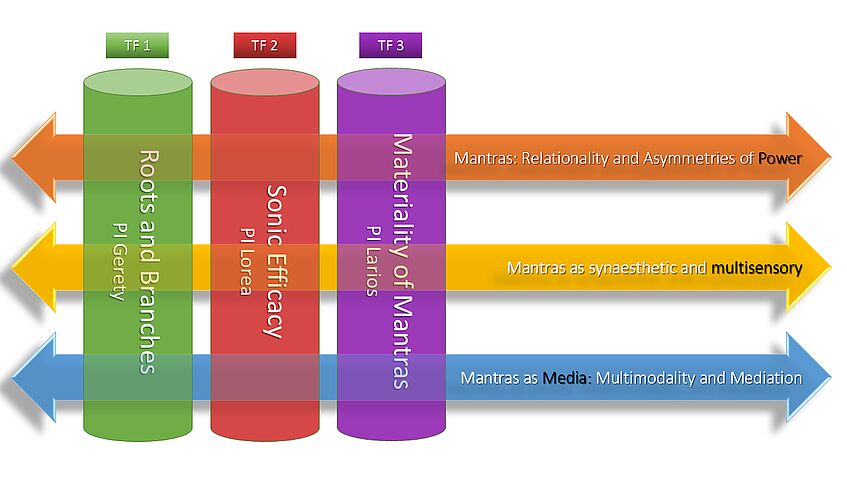MANTRAMS Project - Mantras in Religion, Media and Society in Global Southern Asia
[ERC Synergy Grant -101118934]
Over 4 million people in Europe, including Hindu, Buddhist, Sikh minorities, and Yoga practitioners, use mantras—sacred utterances, formulas, or syllables—for ritual, prayer, contemplation, and wellness. Despite their widespread use and the term’s integration into modern European languages, mantras have rarely been studied comprehensively.
The MANTRAMS Project, funded by a European Research Council (ERC) Synergy Grant, addresses this gap with a six-year initiative and a budget of €9,651,263. This project will produce an unprecedented global history and anthropology of mantras, leveraging the expertise of leading scholars on Southern Asia, where mantras have been used for over 3,000 years. It will examine how mantras have been transmitted through spaces, media, and religious communities, including diasporic networks, new religious movements, yoga, and the internet.
Using an interdisciplinary approach that includes Indology, anthropology, sound studies, media studies, art history, and the history of religions, the project will create comprehensive sonic, visual, and digital textual archives. These archives will document the transcultural and multisensory dimensions of mantras, culminating in a museum exhibition and a wide range of academic deliverables.
Our project has been developed in dialogue with communities of scholars and practitioners from Asia. Grounded in ethical international collaborations, our research emphasizes respect for local communities, traditional lineages and custodians of cultural heritage.
We embrace a diversity of perspectives and approaches. This means that we do not regard any single viewpoint as universally legitimate or inherently more scientifically valid than others. MANTRAMS team members critically reflect upon their own positions in relation to the topic that they study. This openness and self-reflexivity allows the project to benefit from a multiplicity of approaches, including insiders’ perspectives, scholar-practitioners, heritage learners, and practice-led research.
Key Features
- Interdisciplinary Approach: Integrates diverse methodologies to explore mantras from multiple perspectives.
- Three Cross-Cutting Themes:
-
- Mantras as Media: Investigating the multimediality of mantras and their role in mediation.
- Synaesthetic and Multisensory Engagement: Examining sensory, embodied and perceptual dimensions of mantras.
- Relationality and Power: Analyzing the social and political implications of mantras.
-
Meet the Team
Our team
The MANTRAMS Project is led by a distinguished team of principal investigators:

Borayin Larios
Professor for Modern South Asian Studies at the University of Vienna.

Carola Lorea
Junior Professor for Global Religion at the University of Tübingen

Finnian Gerety
Senior Research Fellow in Asian and Middle Eastern Studies at the University of Oxford
Additionally, Lead Researcher Andrea Acri from the École Pratique des Hautes Études (EPHE) also leader of his own ERC Consolidator MANTRATANTRAM project (“Monsoon Asia as the Nexus for the Transfer of Tantra along the Maritime routes”) and Senior Researcher Gudrun Bühnemann from the University of Wisconsin-Madison contribute their extensive expertise. Together, they aim to bridge gaps in understanding the complex phenomenon of mantras. In addition, an international team of collaborators based across the globe will contribute to the project’s interdisciplinary approach, providing diverse perspectives and insights into the global, historical, and cultural dimensions of mantras. This collaborative effort will enhance the project’s ability to produce a comprehensive and nuanced analysis of mantras, fostering a deeper understanding of their significance across different contexts and media.

Our Research Themes
Our research is organisez around three central themes:

Mantras as Media
Synaesthetic and Multisensory
Relationality and Power
Each theme is investigated using interdisciplinary methods to ensure a comprehensive understanding of mantras.
Three Task Forces
To put our intellectual agenda into research practice, this project is structured in three Task Forces (TFs) and eight Research Components (RCs) that integrate the main themes. One PI will act as coordinator and leader of each Task Force. Although all the TFs involve mixed methodology and an interdisciplinary team, TF1 is predominantly historical-philological, TF2 is primarily anthropological, and TF3 relies more heavily upon material and visual culture analysis. In addition to the three PIs, Lead research collaborator Acri and Senior advisor and researcher Bühnemann are in charge of specific Research Components in their domains of expertise.
Led by PI Gerety in collaboration with Andrea Acri
This task force investigates the origins, development, and diffusion of mantras across different cultures, languages, and time periods. It seeks to understand how mantras have evolved and spread, their connections to power and patronage, and their prominence beyond their original contexts.
Led by PI Lorea
This task force focuses on the role of sound in religious practices, examining how mantras and other sonic elements contribute to spiritual and communal experiences.
Led by PI Borayin Larios with SR Gudrun Bühnemann
This task force investigates the material aspects of mantras, including their visual, embodied, and digital forms, and their impact on individuals and communities.
Each research component is designed to address specific aspects of the study of mantras, from their historical roots and cultural diffusion to their material and digital representations. The combined efforts of these task forces aim to provide a comprehensive understanding of the complex role of mantras across various contexts and media.
TASK FORCE 1: Roots and Branches: Emergence and Circulation of Mantras
Led by PI Gerety in collaboration with Andrea Acri
This task force investigates the origins, development, and diffusion of mantras across different cultures, languages, and time periods. It seeks to understand how mantras have evolved and spread, their connections to power and patronage, and their prominence beyond their original contexts.
RC1: Vedic Mantras: Tradition and Innovation
- Objective: To explore the historical development of Vedic mantras and their impact on later traditions.
- Methodology:
- Textual Analysis: Study of Vedic texts, including the Jaiminīya Brāhmaṇa and Jaiminīya Upaniṣad-Brāhmaṇa.
- Fieldwork: Investigation of Vedic practices in South India, focusing on the Nampūtiri and Cōḻīya Brahmin communities.
- Ethnographic Documentation: Use of sound recording, photography, and video to document Vedic rituals.
- Outcomes:
- Detailed analysis of Vedic ritual practices and their evolution.
- Digitized texts and audiovisual materials for public access.
- Contributions to the Roots of Mantra sourcebook and other publications.
RC2: Tantric Mantras Across Boundaries
- Objective: To examine the transcultural and transreligious dimensions of Tantric mantras.
- Methodology:
- Textual Research: Analysis of Sanskrit and vernacular Tantric literature from medieval to modern periods.
- Field Research: Study of mantras in Southeast and East Asia, including their adaptation in Old Javanese texts and contemporary contexts.
- Collaboration: Work with experts on Tantric traditions and translations of relevant texts.
- Outcomes:
- Comprehensive study of Tantric mantras’ migration and adaptation.
- Publications on the role of mantras in Southeast and East Asia.
- Translation and study of mantric literature in Classical Chinese.
RC3: Mantras and Yoga
- Objective: To investigate the role of mantras in early Yoga and their evolution through Tantric traditions.
- Methodology:
- Historical Analysis: Study of early Yogic texts and their use of mantras.
- Fieldwork: Examination of contemporary practices involving mantras in Yoga.
- Cross-Cultural Studies: Comparison of mantras and Yoga across different traditions and modern practices.
- Outcomes:
- Analysis of the role of mantras in Yogic practices and their soteriological functions.
- Study of global spiritual practices related to mantras and Yoga.
- Publications and contributions to the project’s digital archives.
TASK FORCE 2: Sonic Efficacy
Led by PI Lorea
This task force focuses on the role of sound in religious practices, examining how mantras and other sonic elements contribute to spiritual and communal experiences.
RC4: Religious Sound, Religious Space: Mantras in Sonic Soteriology and Place-Making
- Objective: To explore how mantras interact with other sacred sounds and contribute to the creation of religious spaces and communities.
- Methodology:
- Fieldwork: Ethnographic study of sonic practices in various religious contexts in South Asia.
- Sonic Ethnography: Collection and analysis of sound recordings from rituals and practices.
- Discourse Analysis: Examination of public debates and cultural representations of religious sounds.
- Outcomes:
- Insights into the role of mantras in shaping soundscapes and religious spaces.
- Documentation and analysis of sonic practices in various contexts.
- Contributions to sound studies and anthropological literature.
RC5: Mantras from Below: Ensounding the Margins
- Objective: To investigate how marginalized communities use and reinterpret mantras, often in resistance to dominant religious and social structures.
- Methodology:
- Ethnographic Research: Study of mantras in marginalized communities such as Dalits, Adivasi, and Muslim-majority societies.
- Case Studies: Detailed analysis of vernacular mantras and their social significance.
- Collaboration: Work with local researchers and practitioners to understand grassroots uses of mantras.
- Outcomes:
- Exploration of how mantras function as tools of social agency and resistance.
- Publications on the role of mantras in marginalized communities.
- Development of new theoretical frameworks for understanding mantra practices from below.
TASK FORCE 3: Materiality of Mantras
Led by PI Borayin Larios with SR Gudrun Bühnemann
This task force investigates the material aspects of mantras, including their visual, embodied, and digital forms, and their impact on individuals and communities.
RC6: Material Mantras in Popular Hinduism
- Objective: To study how mantras are materialized in objects and media, and how this affects their social and religious significance.
- Methodology:
- Material Culture Studies: Analysis of mantra-inscribed objects and their uses in various contexts.
- Fieldwork: Investigation of mantra artifacts in urban centers like Mumbai and Pune.
- Exhibition: Collaboration with museums to showcase mantra artifacts.
- Outcomes:
- Analysis of the materiality of mantras and their socio-political implications.
- Interactive exhibition on material mantras.
- Publications on the commodification and global circulation of mantras.
RC7: Digital Mantras
- Objective: To explore how mantras are represented and utilized in digital spaces and how this affects religious practices and communities.
- Methodology:
- Digital Ethnography: Study of mantras on social media platforms and digital media.
- Case Studies: Analysis of digital practices related to charismatic movements and Hindu nationalist groups.
- Collaborations: Work with researchers on digital religion and media studies.
- Outcomes:
- Understanding of how digital formats reshape religious practices and communities.
- Publications on the role of digital media in the spread and transformation of mantras.
- Contributions to discussions on digital religion and media studies.
RC8: Visible Mantras
- Objective: To examine the visual and written representations of mantras in Hindu and Jain traditions, past and present.
- Methodology:
- Visual Analysis: Study of mantras on textiles, amulets, and other objects.
- Field Research: Investigation of the use of mantras in ritual and everyday contexts.
- Collaborations: Work with experts in art history and critical museology.
- Outcomes:
- Analysis of how visual representations of mantras reflect and shape religious practices.
- Publications and exhibitions on the visual materiality of mantras.
- Contributions to the understanding of mantra as a visual and embodied practice.

Contact us
For more information about the project, please contact us.
Contact Information:
- Email: mantrams.stb@univie.ac.at
- Phone: +43-1-4277 43512
Job Opportunities
Call for applications – ERC project « MANTRAMS »
Call for applications
The Department of South Asian, Tibetan and Buddhist Studies (ISTB) at the University of Vienna is pleased to announce two research positions as part of Task Force 3 of the ERC-funded Synergy Project MANTRAMS (Mantras in Religion, Media, and Society in Global Southern Asia). Weinviteapplicationsfor:
- Postdoctoral Researcher (2 years, extendable)
- Predoctoral Researcher (3 years, not extendable)
The focus of Task Force 3 Materiality of Mantras is on the material aspects of mantras, which include their inscriptional, visual, embodied, and digital forms. The goal of this task force is to investigate how mantras affect and interact with individuals, communities, and environments. This examination covers both the physical and digital forms of mantras, exploring their importance in shaping identity, social structures, and their representation in various media formats. For detailed job descriptions and application instructions, please refer to the following documents:
- Postdoctoral Researcher: Material Religion of Contemporary Hindu Traditions (job description, PDF)
- Predoctoral Researcher: Study on the Materiality of Mantras in Popular Hinduism (job description, PDF)
Related Files
To view all job vacancies, visit >>
